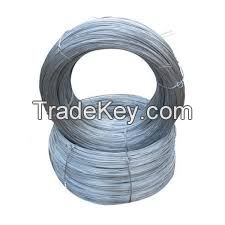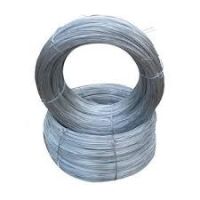Binding Wire
- Location: Philippines
- FOB Price: 450 ~ 490 ( Negotiable )
- Minimum Order Quantity: 5 Ton
- Packaging Detail: Buyer request
- Delivery Time: 7-21 days Day
- Supplying Ability: 80000
- Payment Type: T/T, Western Union, Money Gram
Product Description click to expand contents
Binding Wire
Binding wire is a type of steel wire commonly used for tying or binding objects together. It is made of mild steel and is typically coated with zinc to enhance its resistance to corrosion (galvanized binding wire). Binding wire is widely used in construction, agriculture, and other industries for securing items, bundling materials, and supporting structures.
Key Characteristics of Binding Wire:
Material Composition: Binding wire is often made from mild steel or carbon steel, but it can also be galvanized to provide increased corrosion resistance for outdoor and exposed applications.
Flexibility: Binding wire is known for its flexibility, making it easy to bend, twist, and tie objects securely without breaking.
Strength: Despite its flexibility, binding wire is strong enough to hold materials together, making it ideal for use in various industrial and construction applications.
Coating: Binding wire can be galvanized (zinc-coated) to improve its durability and resistance to rust, especially when used in environments prone to moisture or corrosion.
Sizes: Binding wire is available in various gauge sizes (thickness), from thin wires used for light-duty applications to thicker wires used for heavier binding tasks.
Common Applications:
1. Construction: Binding wire is widely used in construction for reinforcing bars (rebar). It ties steel reinforcement rods together to create a strong and stable foundation for concrete structures. It helps in maintaining the correct spacing and alignment of the reinforcement mesh.
2. Agriculture: In agriculture, binding wire is used to bind plants, such as tying vines or crops to trellises, or securing plants to poles or stakes. It is also used to bundle agricultural products like hay and straw.
3. Packaging and Bundling: Binding wire is used to bundle items together, such as pipes, wire rods, or small parts, ensuring they remain tightly secured during transportation and storage.
4. Electrical Industry: In the electrical industry, binding wire can be used for wiring and cable management, helping to secure cables and wires together in tight spaces.
5. Manufacturing: In manufacturing, binding wire is used for holding parts or components together temporarily or during assembly, especially in metalworking and machinery.
6. DIY and Craft Projects: Binding wire is also popular for crafting and DIY projects, such as creating sculptures, models, or floral arrangements, due to its ease of use and flexibility.
Benefits of Binding Wire:
Durability: When galvanized, binding wire becomes resistant to rust and corrosion, making it suitable for use in outdoor and moisture-prone environments.
Ease of Use: Binding wire is easy to work with, as it can be bent, twisted, and cut without difficulty. It provides a strong hold with minimal effort.
Cost-Effective: Binding wire is generally affordable and is a widely used material due to its versatility and low cost.
Strength-to-Weight Ratio: It provides a strong binding solution without being too bulky or heavy, making it ideal for tasks that require secure ties without adding excessive weight.
Wide Availability: Binding wire is readily available in various gauges and lengths, allowing it to be used in different applications based on the required strength and flexibility.
Drawbacks:
Limited Corrosion Resistance (if not galvanized): If not coated or treated, uncoated binding wire can corrode and rust when exposed to moisture, reducing its lifespan and effectiveness.
Limited Aesthetic Appeal: The wire may appear utilitarian and may not be aesthetically appealing for decorative or visible applications.
Brittleness with Age: Over time, and especially with repeated bending, binding wire can become brittle, making it more prone to breaking.
Summary: Binding wire is a flexible, strong, and cost-effective material used in various industries for securing and bundling objects. Its primary use is in construction for tying reinforcement bars and supporting the structure of concrete, but it also has widespread applications in agriculture, manufacturing, packaging, and even DIY projects. Available in both galvanized and uncoated forms, binding wire offers a simple yet reliable solution for tasks requiring secure bindings.


Binding wire is a type of steel wire commonly used for tying or binding objects together. It is made of mild steel and is typically coated with zinc to enhance its resistance to corrosion (galvanized binding wire). Binding wire is widely used in construction, agriculture, and other industries for securing items, bundling materials, and supporting structures.
Key Characteristics of Binding Wire:
Material Composition: Binding wire is often made from mild steel or carbon steel, but it can also be galvanized to provide increased corrosion resistance for outdoor and exposed applications.
Flexibility: Binding wire is known for its flexibility, making it easy to bend, twist, and tie objects securely without breaking.
Strength: Despite its flexibility, binding wire is strong enough to hold materials together, making it ideal for use in various industrial and construction applications.
Coating: Binding wire can be galvanized (zinc-coated) to improve its durability and resistance to rust, especially when used in environments prone to moisture or corrosion.
Sizes: Binding wire is available in various gauge sizes (thickness), from thin wires used for light-duty applications to thicker wires used for heavier binding tasks.
Common Applications:
1. Construction: Binding wire is widely used in construction for reinforcing bars (rebar). It ties steel reinforcement rods together to create a strong and stable foundation for concrete structures. It helps in maintaining the correct spacing and alignment of the reinforcement mesh.
2. Agriculture: In agriculture, binding wire is used to bind plants, such as tying vines or crops to trellises, or securing plants to poles or stakes. It is also used to bundle agricultural products like hay and straw.
3. Packaging and Bundling: Binding wire is used to bundle items together, such as pipes, wire rods, or small parts, ensuring they remain tightly secured during transportation and storage.
4. Electrical Industry: In the electrical industry, binding wire can be used for wiring and cable management, helping to secure cables and wires together in tight spaces.
5. Manufacturing: In manufacturing, binding wire is used for holding parts or components together temporarily or during assembly, especially in metalworking and machinery.
6. DIY and Craft Projects: Binding wire is also popular for crafting and DIY projects, such as creating sculptures, models, or floral arrangements, due to its ease of use and flexibility.
Benefits of Binding Wire:
Durability: When galvanized, binding wire becomes resistant to rust and corrosion, making it suitable for use in outdoor and moisture-prone environments.
Ease of Use: Binding wire is easy to work with, as it can be bent, twisted, and cut without difficulty. It provides a strong hold with minimal effort.
Cost-Effective: Binding wire is generally affordable and is a widely used material due to its versatility and low cost.
Strength-to-Weight Ratio: It provides a strong binding solution without being too bulky or heavy, making it ideal for tasks that require secure ties without adding excessive weight.
Wide Availability: Binding wire is readily available in various gauges and lengths, allowing it to be used in different applications based on the required strength and flexibility.
Drawbacks:
Limited Corrosion Resistance (if not galvanized): If not coated or treated, uncoated binding wire can corrode and rust when exposed to moisture, reducing its lifespan and effectiveness.
Limited Aesthetic Appeal: The wire may appear utilitarian and may not be aesthetically appealing for decorative or visible applications.
Brittleness with Age: Over time, and especially with repeated bending, binding wire can become brittle, making it more prone to breaking.
Summary: Binding wire is a flexible, strong, and cost-effective material used in various industries for securing and bundling objects. Its primary use is in construction for tying reinforcement bars and supporting the structure of concrete, but it also has widespread applications in agriculture, manufacturing, packaging, and even DIY projects. Available in both galvanized and uncoated forms, binding wire offers a simple yet reliable solution for tasks requiring secure bindings.


Contact Information click to expand contents
- Contact Person: Ms. GARCES JAMILLE BALLESTEROS (Director)
- Company: Elite Goods Trading
- Address: Philippines
- Telephone: 63-9451574014
- Mobile: 639451574014
Company Profile click to expand contents
- Elite Goods Trading
- [ Philippines ]
-

-
Overview: Elite Goods Trading Company is a dynamic and innovative trading company based in Manila, Philippines. Specializing in the import and export of high-quality goods, we cater to a wide range of industries, ensuring the delivery of superior products that meet the diverse needs of our clients. Our focus is to foster long-term relationships with both suppliers and customers through professi...
Basic Information
- Business Type: Others
- Company Products / Services: bpa paper,label paper,jumbo thermal paper,tissue paper,jumbo tissue paper,napkin roll,tissue paper roll,jumbo napkin roll,wax paper,bond paper,absorbent paper,copper tube,copper sheet,copper wire coil,coated steel,coated aluminum
- Year Established: 2023
- Number of Employees: 51-100


